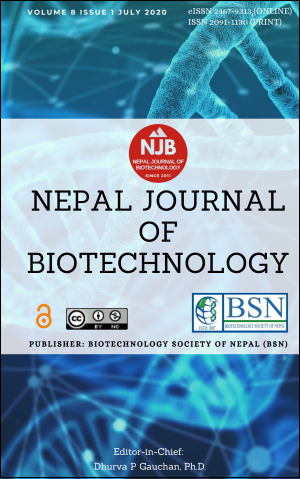Phytochemicals Levels and Antioxidant Capacities of Figs Flowers Fruits
DOI:
https://doi.org/10.3126/njb.v8i1.30207Keywords:
Antioxidant capacity, Bakor, Figs flowers, Figus carica, Methanol extracts, DPPHAbstract
Since antiquity, phenolic compounds produced by plants were known as free radical scavengers and as powerful antioxidants. Huge interest has been made by researchers to the traditional uses of medicinal plants against illnesses related to oxidative stress. This study measures the correlation that can be existed between the antioxidant capacity and phytochemical s levels of four varieties of Ficus carica fruits, figs flowers or "Bakor" as called locally in Algeria. Therefore, extracts were assessed for determining their antioxidative potentials using both test of total antioxidant capacity and DPPH (1,1-diphenyl-2-picrylhydrazyl) free radical scavenging test followed by quantitative phytochemical analysis to estimate the total flavonoid level (TFL), the total phenolic level (TPL), the total anthocyanin level (TAL) and the condensed tannins level of plants methanolic extracts. A positive correlation was observed between phenolics content and the antioxidant capacity of figs flowers methanol extracts. The methanolic extract of Bechar (MeOH Var.2) chelated 87,9± 1,23 % of the DPPH free radical with IC50 value equal to 0,185 mg/g DW. A high antioxidant ability of almost all extracts is, probably, related to the appreciable rates of flavonoids, phenolics and tannins showed by those fig extracts. The highest value of phenolics level was detected among the variety 1 methanolic extract of Bechar (MeOH Var.1) of 10,4 mg GAE/g DW.
Downloads
Downloads
Published
How to Cite
Issue
Section
License
Copyright Notice:
The manuscript submitted to NJB must be an original contribution, not previously published and should not be under consideration for publication elsewhere. When the manuscript is accepted for publication, the authors agree to automatically transfer the copyright of the article to the publisher. It should grant permission to any third party, in advance and in perpetuity, the right to use, reproduce or disseminate your article, according to the NJB copyright and license agreement.
Authors transfer copyright to the publisher as part of a journal publishing agreement but have the rights to: Share their article for Personal Use, Internal Institutional Use and Scholarly Sharing purposes, with the NJB applies the Creative Commons Attribution-NonCommercial CC BY-NC license to all the works we publish after Jun 2020 (Before it was CC BY-NC-ND). Under this license, authors agree to make articles legally available for reuse, without permission or fees, for virtually any non-commercial purpose. Anyone may remix, adapt, and build upon your work non-commercially, and although their new works must also acknowledge you and be non-commercial, they don’t have to license their derivative works on the same terms. More details on CC BY-NC refer to its Licence Deed and Legal Code.






